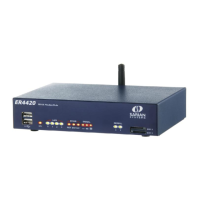Configure Ethernet interfaces
Digi TransPort User Guide 155
Advanced Ethernet parameters
On routers with only one Ethernet port, there may be multiple configurable Ethernet instances.
Ethernet 0 is the physical interface. These extra instances are treated as logical Ethernet ports
and can be used to assign more than one Ethernet IP address to a router.
On routers with more than one physical Ethernet port, the Ethernet instances refer to the
different physical Ethernet ports. These routers can be configured for either HUB mode or Port
Isolate mode.
In HUB mode all the Ethernet ports are linked together and behave like an Ethernet hub or
switch. This means that the router will respond to all of its Ethernet IP addresses on all of its
ports (as the hub/ switch behavior links the ports together).
In Port Isolate mode the router will only respond to its Ethernet 0 IP address on physical port LAN
0, its Ethernet 1 IP address on physical port LAN 1, etc. The router will not respond to its Ethernet
1 address on port LAN 0 unless routing has been configured appropriately.
When configured for HUB mode it is important that no more than one of the router’s Ethernet
interfaces is connected to another hub or switch on the same physical network otherwise an
Ethernet loop can occur. The default behavior is HUB rather than Port Isolate.
Port Isolate mode
If the router is running in Port Isolate mode, the following will be displayed, with an option to
switch to Hub mode.
Hub Mode (factory default)
If the router is running in Hub mode, the following is displayed, with an option to switch to
Port Isolate mode.
Ethernet Hub group
On routers with a built-in hub/switch, the Ethernet Hub Group parameter for each port is
normally set to 0. This means that all ports belong to the same hub. If required however, the
Hub Group parameter may be used to isolate specific ports to create separate hubs. For
example, if Ethernet 0 and Ethernet1 have their Group parameter set to 0 whilst Ethernet 2
and Ethernet 3 have their Group parameter set to 1, the router will in effect be configured as
two 2-port hubs instead of one 4-port hub. This means that traffic on physical ports LAN 0 and
LAN 1 will not be visible to traffic on physical ports LAN 2 and LAN 3 (and vice versa). Group
numbers can be 0-3 or use 255 for an interface to be in all groups. This parameter is not
available on the web page when the router is configured for Port Isolate mode.

